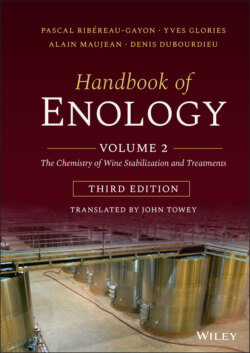Читать книгу Handbook of Enology, Volume 2 - Pascal Ribéreau-Gayon - Страница 20
1.3.1 Total Acidity
ОглавлениеTotal acidity in must or wine, also known as “titratable acidity,” is determined by neutralization using a sodium hydroxide solution of known normality. The end point of the titration is still often determined by means of a colored reagent, such as bromothymol blue, which changes color at pH 7, or phenolphthalein, which changes color at pH 9. Using one colored reagent to define the end point of the titration rather than the other is a matter of choice. It is also perfectly conventional to use a pH meter and stop the total acidity assay of a wine at pH 7, and, indeed, this is mandatory in official analyses. At this pH, the conversion into salts of the second acid function of the diacids (malic and succinic) is not completed, while the neutralization of the phenol functions starts at pH 9.
The total acidity of must or wine takes into account all types of acids, i.e. inorganic acids such as phosphoric acid, organic acids including the main types described above, and amino acids whose contribution to titratable acidity is not very well known. The contribution of each type of acid to total acidity is determined by its strength, which defines its state of dissociation, as well as the degree to which it has combined to form salts. Among the organic acids, tartaric acid is mainly present in must and wine as a monopotassium acid salt, which still contributes toward total acidity. It should, however, be noted that must (an aqueous medium) and wine (a dilute alcohol medium), with the same acid composition and thus the same total acidity, do not have the same titration curve and, consequently, their acid–base buffer capacity is different.
Even using the latest techniques, it is difficult to predict the total acidity of a wine on the basis of the acidity of the must from which it is made, for a number of reasons.
Part of the original fruit acids may be consumed by yeasts and, especially, bacteria (see malolactic fermentation). On the other hand, yeasts and bacteria produce acids, e.g. succinic and lactic acids. Furthermore, acid salts become less soluble as a result of the increase in alcohol content. This is the case, in particular, of the monopotassium form of tartaric acid, which causes a decrease in total acidity on crystallization, as potassium bitartrate (potassium hydrogen tartrate [KHT]) still has a carboxylic acid function.
In calculating total acidity, a correction should be made to allow for the acidity contributed by sulfur dioxide and carbon dioxide. Sulfuric acid is much stronger than carbonic acid .
In fact, high concentrations of carbon dioxide tend to lead to overestimation of total acidity, especially in slightly effervescent (spritzy) wines and even more so in sparkling wines. This is also true of young wines, which always have a high CO2 content just after fermentation.
Wines must therefore be degassed prior to analyses of both total and volatile acidity.
